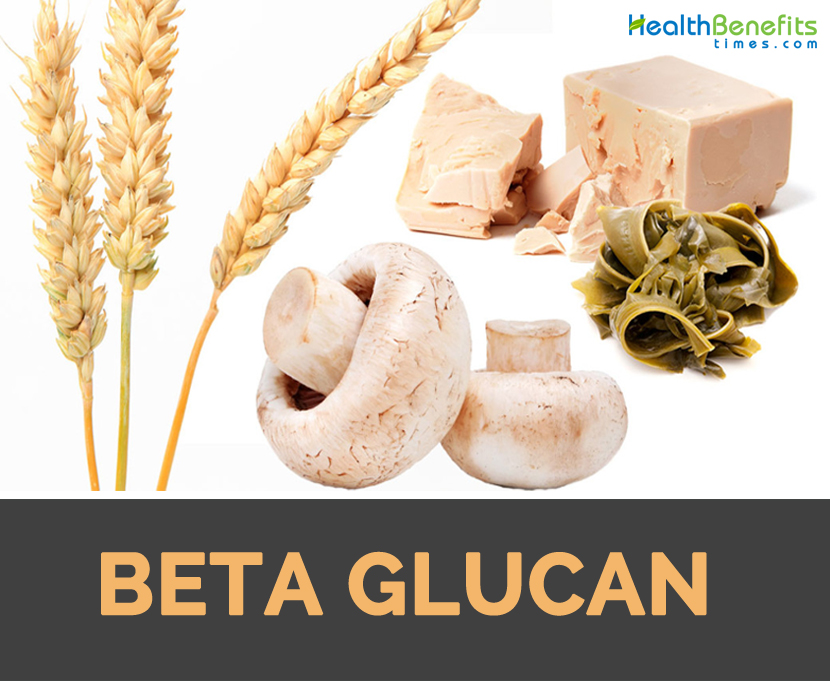 β-Glucans consists a group of β-D-glucose polysaccharides which occurs naturally in cell walls of bacteria, cereal and fungi withvarying physicochemical properties dependent on the source. β-glucans form linear backbone having 1-3 β-glycosidic bonds but vary with respect to solubility, molecular mass, branching structure, viscosity and gelation properties which cause diverse physiological effects in animals. Oat fiber β-glucan lowers blood levels of LDL cholesterol and lowers the chances of cardiovascular diseases. Beta glucans are sugars which are found in cell walls of bacteria, algae, fungi, yeasts, lichens and plants such as barley and oats.
β-Glucans consists a group of β-D-glucose polysaccharides which occurs naturally in cell walls of bacteria, cereal and fungi withvarying physicochemical properties dependent on the source. β-glucans form linear backbone having 1-3 β-glycosidic bonds but vary with respect to solubility, molecular mass, branching structure, viscosity and gelation properties which cause diverse physiological effects in animals. Oat fiber β-glucan lowers blood levels of LDL cholesterol and lowers the chances of cardiovascular diseases. Beta glucans are sugars which are found in cell walls of bacteria, algae, fungi, yeasts, lichens and plants such as barley and oats.
Beta glucans are used for high cholesterol, cancer, diabetes and HIV/ AIDS. It is used to enhance immune system in people with weak immune conditions such as physical or emotional stress, chronic fatigue syndrome. It is useful for flu, colds, H1N1 (swine) flu, hepatitis, allergies, asthma, lyme disease, aging, ear infections. β-Glucans reside to a group of physiologically active compounds known biological response modifiers. It is an immunomodulator which strengthen immune system.
History
Fungal and cereal products have been used for centuries for cosmetic and medicinal purposes. Till 20th century, specific role of β-glucan. In lichens, β-glucans were first discovered. In 1981, a particular interest in oat β-glucan rised after cholesterol lowering effect from oat bran. In 1997, intake of 3 g of β-glucan from oats per day lowers absorption of dietary cholesterol and lower chances of coronary heart disease. Later, approved health claim amended to add these sources of β-glucan: rolled oats (oatmeal), oat bran, whole oat flour, oatrim, whole grain barley and barley beta-fiber.
Health Benefits of Beta-glucan
Some health benefits of Beta-glucan are discussed below:
- Strengthen immunity
Beta-glucans are regarded as naturally occurring polysaccharides. The glucose polymers are constituents of cell wall of some pathogenic bacteria or fungi. For thousands of years, an immunostimulating and healing properties are known in Eastern countries. The mushrooms have biologically active polysaccharides which belong to group of beta-glucans. These substances enhance host immune defense upgrades complement system, enhance macrophages and natural killer cell function. Beta glucans also shows anti-carcinogenic activity. It prevents oncogenesis due to its protective effect against potent genotoxic carcinogens. It inhibits tumor growth in promotion stage too. Anti-angiogenesis is a pathway through which beta-glucans lower proliferation of tumor and prevent tumor metastasis. Adjacent to tumor cells, microorganisms and other host cells lack beta-glucan as a surface component and could not trigger complement receptor 3-dependent cellular cytotoxicity and set up tumor killing activity.
- Lowers cholesterol
Beta-glucan found in oats helps to maintain cholesterol in check. Study conducted over 13 years oat derived beta-glucan lower levels of total and LDL cholesterol. Intake of daily oats is related with 5 percent and 7 percent reductions in total and LDL cholesterol levels respectively.
- Cancer prevention
In healthy individuals, rapid growth of cancer could over-activate immune system of an individual. It binds and activates specific innate immune cells including antibodies, macrophages and natural killer cells that could trigger immune response. Beta glucans is able to modify attack of immune cells on invasive agents which supports an efficient and strong immune response. It stimulates an immune response from NK cells, T-cells, cytokines interleukin 1 and 2 as well as macrophages. It lowers growth rate of cancer cells by stimulating stronger immune response to foreign invaders. NK cells inhibit growth of cancer and responsible to detect and control tumors.
- Combat infection
Beta glucans could mitigate common cold and controls growth of tumor cells. It is known that firefighters are faced with both emotionally and physically taxing responsibilities. Research shows that firefighters who received beta glucan exhibit 23% reduction in infections of upper respiratory tract.
Food Sources
- Beans
- Corn/maize
- Canary seed
- Lentils
- Flax
- Millet
- Rice
- Peas
- Spring wheat
- Spelt
- Winter wheat
- Barley
- Hulless barley
- Oat Barley mutant
Side effects of beta glucans
- Side effects include nausea, diarrhea and vomiting.
- When beta gluca is injected directly to bloodstream, one could experience side effects such as: back pain, joint pain, diarrhea, rash, dizziness, chills, fever, irregular blood pressure and swollen lymph nodes.
References:
https://www.webmd.com/vitamins/ai/ingredientmono-1041/beta-glucans
https://en.wikipedia.org/wiki/Beta-glucan
https://www.drugs.com/npc/beta-glucans.html
https://www.cancertutor.com/beta-glucan/
https://www.healthline.com/health/beta-glucan-cancer#outlook
https://www.ncbi.nlm.nih.gov/pubmed/17895634
https://thetruthaboutcancer.com/beta-glucans-immunity-fight-cancer/
